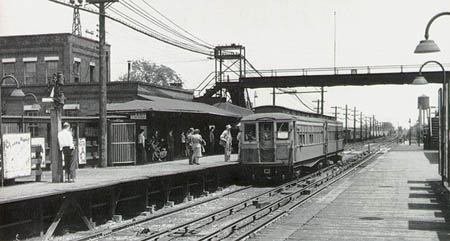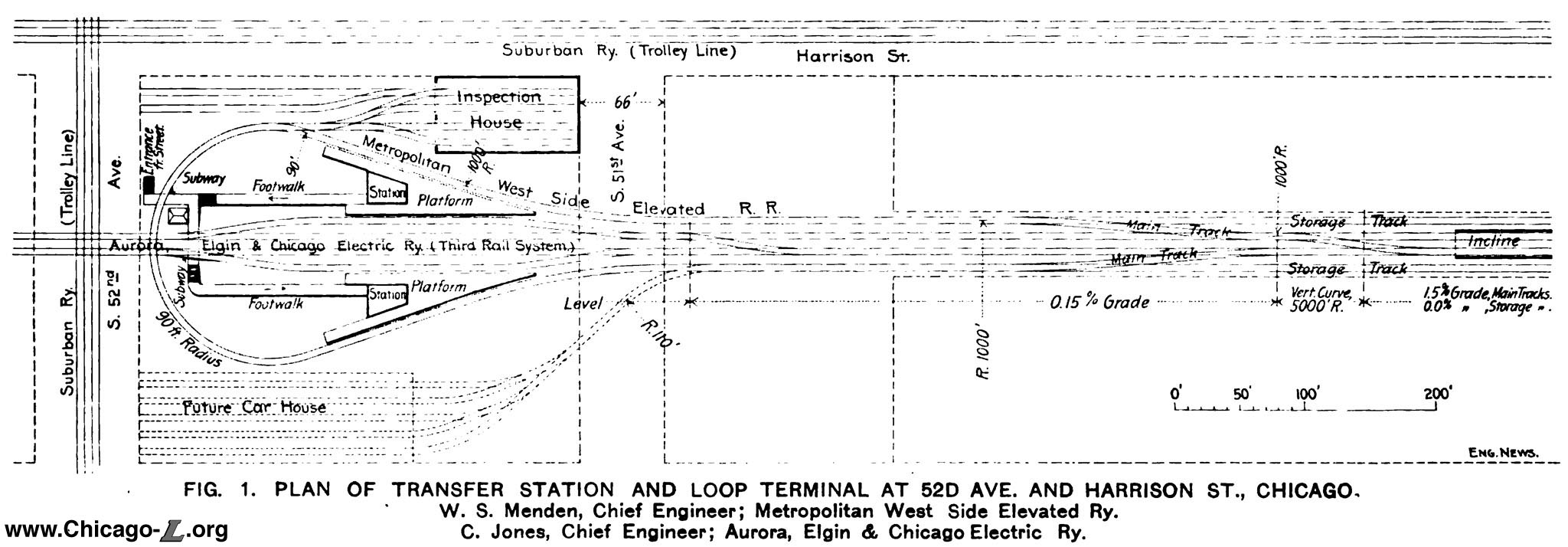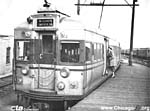|
|
|
|
 Eventually, the outer two of four tracks were removed and the platforms widened to reach the inside two. (Photo from the William H. Flagg/Bruce G. Moffat Collection) |
|
|
|
|
 Eventually, the outer two of four tracks were removed and the platforms widened to reach the inside two. (Photo from the William H. Flagg/Bruce G. Moffat Collection) |
Laramie
(5200W/600S)
Laramie Avenue and
Harrison Street, Austin
Service Notes:
Garfield Line
Quick Facts:
Address: TBD
Established: August 17, 1902
Original Line: Metropolitan West Side Elevated, Garfield Park branch
Previous Names: 52nd Avenue
Rebuilt: n/a
Skip-Stop Type:
Station
Status: Demolished
History:

From 1902 to 1905, AE&C trains ended their eastbound runs at 52nd. This two car AE&C has already discharged it passengers, changed ends and is pulling into the westbound platform to pick up connecting "L" passengers. For a larger view, click here. (Photo from the Shore Line Interurban Historical Society)

Track diagram and site layout of 52nd Avenue Yard, as it appeared when it opened in 1902. For a larger view, click here. (Image from Engineering News) |
In mid-July, 1902, it was reported that occasional service was being run to 52nd Avenue, with regular service to the station was inaugurated August 17, 1902. At the same time, the Aurora, Elgin & Chicago interurban began service from this station west, providing a connection for "L" passengers. The new terminal included a turning loop, yard and four-track inspection shop to replace the one at 46th.
The 52nd Avenue terminal was described in great detail in a 1902 Engineering News article:
The advantages of loop terminals over dead-terminals for elevated railways, with their traffic, have several times been pointed out, but the first road to adopt this system is the Metropolitan West Side Elevated R.R. of Chicago, which has recently completed a loop terminal at the end of its Douglas Park line and is now building similar terminal at the end of its Garfield line. It also intends to build loops at its outlying terminals. With the loop system there need be no holding of trains outside the during the busy hours, caused by a slight delay of a train at the unloading platform, which delay in the case of a dead end terminal necessitates holding all incoming trains until the offending train has backed out in the face of these trains The dead end terminal at a transfer station with continuous track would also entail an inconveniently long walk on the part of passengers from one train or car to another. The great advantage of the loop lies in the fact that it eliminates all switching and reverse movements, the trains moving ahead all the time and following each other closely. The present end of the Garfield Park line is a dead end station at 48th Ave., but a new station with single track loop connecting the inbound and outbound tracks is now being built on the street level at 52d Ave., approached by an incline with a grade of 0.9% from 48th Ave...
This station will be used as a transfer station for passengers on the trains of the Metropolitan Elevated R.R. and those on the interurban cars of the Chicago, Aurora & Elgin Electric Ry. This latter line is a double track surface road, built on its own right of way and intended to be operated at high speeds using the third rail system. At some later period the interurban cars may perhaps be run over the line of the elevated railway to the business district of the city, but no such plan is yet contemplated and passengers will therefore transfer at 52d Ave.
Beyond the foot of the incline there are four tracks, 12 ft. c. to c., the two outer tracks being used for storage. The two tracks on the incline begin to spread at the foot of the incline near 50th Ave., turning out to connect with the outer lines by curves of 1,000 ft. radius... As these main tracks approach the station they again turn outward by curves of 500 ft. radius followed by tangents leading to the semicircular terminal loop of 90 ft radius... The interurban railway has two main tracks which cross the loop at grade and each of these has a turnout which runs parallel with the main tracks. On each side of the station is a triangular platform, having the elevated railway and interurban railway tracks on opposite sides. Thus a Metropolitan train arriving from the city discharges its passengers at the same platform from which the interurban cars start. The train then runs around the loop to the other platform, ready to receive passengers who have arrived on an interurban car and wish to proceed to the city. The platforms are long enough for trains of five cars the elevated railway. The interurban cars transferred from the inbound to the outbound track of their road by a crossover with curves 250 ft. radius.
There are two small station buildings of red pressed brick, one at each platform, the platforms being covered by umbrella roofs of corrugated iron supported by light steel columns and transverse trusses... The entire area of the station grounds is enclosed by a fence and access to the platforms can only be obtained through the ticket offices of the station buildings on 52d Ave. Passengers passing between the transfer station and the street or the 52d Ave. cars of the Suburban Ry. cross the loop and interurban tracks by means of subways built of concrete and having roofs of I-beams and concrete.
The arrangement of this transfer station was planned under the direction of Mr. W.S. Menden, Chief Engineer of the Metropolitan West Side Elevated R.R., and Mr. C. Jones, Chief Engineer of the Aurora, Elgin & Chicago Electric Ry. The construction work was done by Agnew & Co. of Chicago, except that all track work was done by the Metropolitan Ry.1
This station served as the terminal for the Garfield Park branch until the line was extended to Desplaines Avenue on March 11, 1905. Initially, only shuttle trains ran between Desplaines and 52nd Avenue; passengers had to transfer at 52nd to a train to the city, but didn't have to pay a second fare. Through shuttles to the city began in 1906 during rush hours. Eventually, a local through train was added. Meanwhile, AE&C had been extended beyond 52nd Avenue into downtown Chicago earlier, on February 23, 1905, when the city altered their franchise agreement to allow them to operate into the Wells terminal downtown. At that time, the CA&E discontinued stopping at Laramie.
52nd Avenue was renamed Laramie Avenue in 1913. The stationn changed names with the street.
On August 1, 1927, the Insull group (who owned the Rapid Transit Company by that time) obtained control of the CA&E. After successfully adding a stop at Canal for interurban trains so west suburban passengers could connect with Union Station, a stop at Laramie was added beginning in 1928.2
On December 9, 1951, the Chicago Aurora & Elgin discontinued stopping at Laramie and began stopping at Cicero concurrent with their resumption of local service to stations in Maywood and Bellwood.
The station was closed in 1958 when the entire Garfield Park branch was closed to make was for the Eisenhower Expressway and the new Congress Line therein, and demolished thereafter. A new Laramie station was never constructed, but the Lavergne entrance to the Cicero Congress station was a few blocks southeast.
 This view from the opposite end the station shows an "L" train turning on the loop track. (Photo from the Fred D. Lonnes Collection) |
![]()
 |
cta5001c.jpg
(114k) |
|
1. "Loop Terminals and Transfer Station Metropolitan Elevated RR Chicago." Engineering News, Vol. XLVIII No. 7 (Aug 14, 1902), p. 115-116.
2.
Plachno, Larry. The Story of the Chicago Aurora & Elgin Railroad 2 -- History. Transportation Trails, 1989, p. 313.